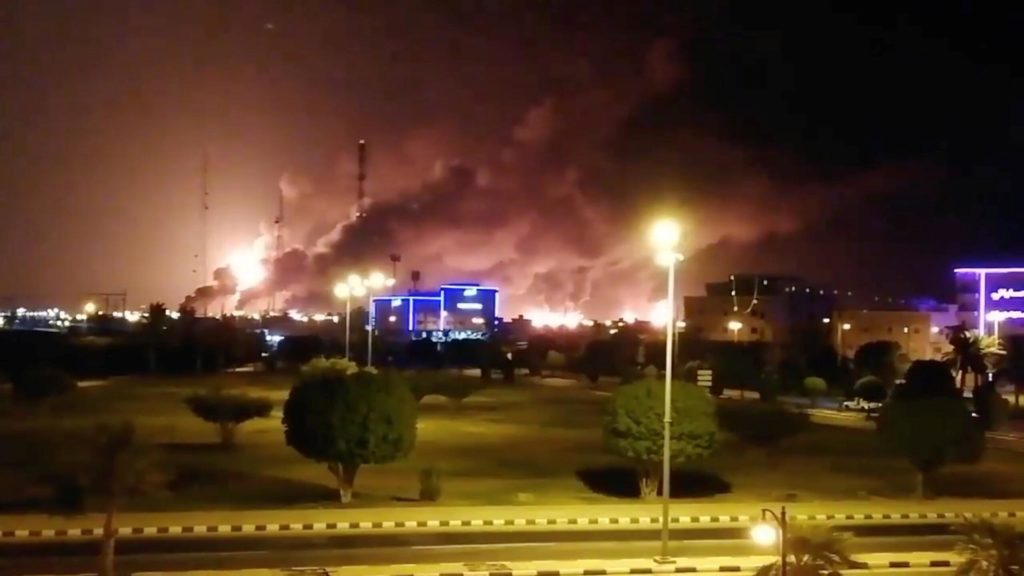Written by Dr. Leon Tressell exclusively for SouthFront
Last Saturday’s attack upon Saudi Arabia’s oil facilities at Bqaiq and Khurais, that has slashed its oil production in half, has made media headlines around the world. This attack which has caused alarm for its upward pressure upon oil prices and the potential impact upon the global economy should come as no surprise.
This Houthi strike is the just the latest in a series of attacks upon Saudi oil infrastructure over the last few months. On August 17 Houthi Qasef-K2 suicide drones attacked the Al-Shaybah super giant oil field and its main oil refinery.
Besides this, the Houthis have repeatedly targeted several Saudi airports both civilian and military in the southern provinces of Jizan and Narjan with ballistic missiles and drones. On August 26 a batch of Sammad-3 missiles hit a military target in the Saudi capital of Riyadh.
All talk of Iran being responsible for knocking out 50% of Saudi oil production reveals a lack of knowledge of Houthi military capabilities. Geopolitical analyst Patrick Cockburn has noted how Saudi Arabia has consistently underestimated the military capabilities of the Houthis at great cost to itself. The latest Houthi attack is a sign of how poor countries are levelling the playing field
against wealthy ones armed with the fairly low cost weapons such as drones.
The dictatorship of Saudi Arabia is also suffering heavy casualties in its land war in Yemen. Since the beginning of 2019 Houthi soldiers have launched a series of cross border raids into the Saudi provinces of Jizan and Najran that inflicted heavy casualties upon Saudi coalition forces. On August 22 Houthi forces captured a series of Saudi fortifications on strategic hilltops west of al-Sudias mountain in Najran province.
These defeats have been compounded by the Saudi rupture with is close ally that notable bastion of dictatorship the United Arab Emirates (UAE). The UAE has not only withdrawn a large number of troops from fighting against the Houthis but have armed their own southern separatist militia that has captured the port city of Aden from Saudi backed forces. These Saudi backed militias are loyal to the UN recognised government of Hadi which represents nobody but its Saudi masters in this multidimensional conflict.
The quagmire that Saudi forces have become immersed in threatens to become worse due to its troops moving into Yemen’s eastern most province of Al Mahrah that borders Oman. The Saudi intention being to build pipelines across that part of Yemen to reach the Gulf of Aden bypassing the choke point of the Straits of Hormuz.
Saudi Arabia has totally failed to achieve the quick victory that it envisaged when it illegally invaded Yemen in 2015. Now they are bogged down in a bloody stalemate, that is a huge drain upon its treasury, which threatens to its oil industry with an existential crisis.
In its 2019 budget the Saudi dictatorship cut military spending which is to fall 12% compared to 2017 and 16% less than 2017. Military spending peaked in2017 when its reached a third of the total budget. This pushed the budget deficit up to $52 billion which was totally unsustainable. Its public ration debt to GDP has reached a level not seen since the 2008 economic crisis at 19.1% which is forcing Riyadh to cut back its defence expenditure.
The slowdown in the global economy which continues apace is reducing demand from key manufacturing nations such as China. This will put further pressure upon Riyadh which faces an accumulated budget deficit of $149 billion.
The Houthi leadership have made it clear that unless Saudi Arabia withdraws its troops from Yemen then more drone/missile attacks upon its critical oil infrastructure will follow. This poses a huge dilemma for the House of Saud dictatorship and its American backers. More successful attacks upon critical oil infrastructure could not only destroy the Saudi governments main source of income but destabilise the entire global economy that is rapidly slowing down.
Concerns over the impact of further oil price shocks upon the world economy are major factor that might stay the hands of the Saudi and Americans from retaliation against Iran. The global economy cannot afford any more major oil price spikes. The consequences of the oil price spikes in 1973-4 come to mind.
During 1973-4 OPEC instituted an oil embargo on Western nations that had supported Israel during the so called Yom-Kippur War of 1973. The oil embargo led to a 400% increase in the price of oil, that tipped the world economy into recession. At a time when everything Trump does seems geared towards his re-election in 2020 then issues such as this must be a factor in restraining the U.S. from military action against Iran.
The threat of further strikes upon its vital oil infrastructure, budgetary pressures, the quagmire its land forces are facing in Yemen together with the fracturing of its military coalition, that once included Qatar and the U.A.E., may well force Saudi Arabia to seek a withdrawal from its unwinnable war in Yemen. The Saudi dictatorship is aware of how Trump is seeking a way out of the America’s longest war in Afghanistan through negotiations with the Taliban in time for the 2020 election. Following this example the Saudi dictatorship may well seek to find some formula that allows its troops to withdraw from Yemen without losing too much face that would undermine its position both domestically and as a regional power.






